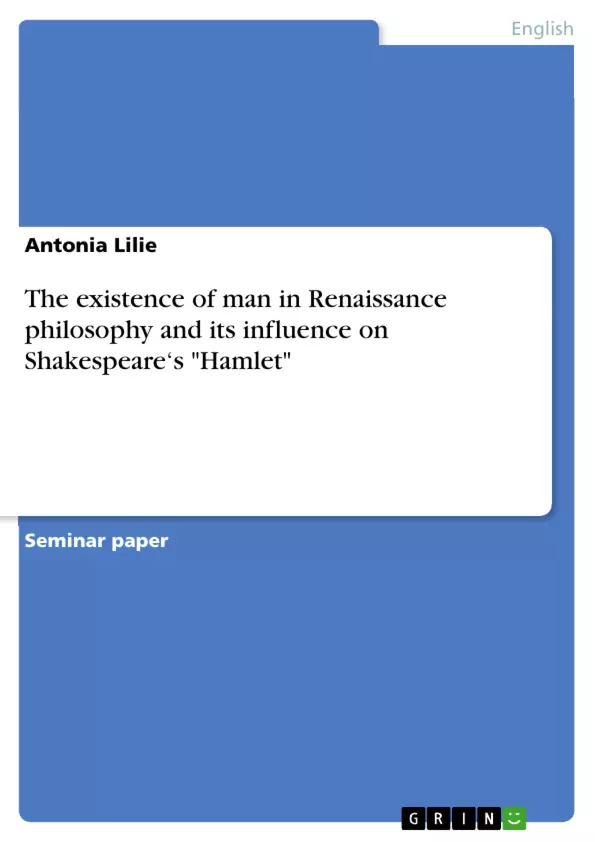Since the publication of William Shakespeare‘s play ‘Hamlet' there have been many different interpretations to approach the text. The following paper focuses on the historical context of the play. Shakespeare lived in a time full of change and rearrangement of perspectives and beliefs. The drama is a genre that was the main source of entertainment in Shakespeare‘s time. Shakespeare´s plays can be divided into three groups: the historical plays that focus on the narration of events in the English monarchy, his comedies and his tragedies. The last two, as they are fictive, are the direct outcome of Shakespeare´s personal perception of his time. One of the characteristics of tragedies is the rise and downfall of a tragic hero, who can either have good intentions as Hamlet or who can be the evil part of the play right from the beginning like Richard III or Macbeth. A tragic hero with good intentions, however, becomes even more tragic: Hamlet tries to set all the things right that seem wrong in his kingdom, but he fails and becomes the victim of his own actions. A hero that seems to look for his place in court, as it has been actively rearranged by his uncle Claudius. Into his great mourning for his father, who has recently died, a ghost appears and tells him to revenge his murder. Hamlet finds himself in a situation full of insecurity and uncertainty, as he can not even be sure about the ghost‘s identity.
Shakespeare lived from 1564-1616, a time that we call the Renaissance Age. Even though art and music seemed to focus on the values of the ancient world, we can find many major discoveries in philosophy and science that changed the whole perspective people had on the world and on humanity. This paper tries to reveal what influence this new world-picture and the existence of man had on Shakespeare‘s writing, especially on his longest play ‘Hamlet‘.
Table of Contents
- Introduction
- Renaissance world-picture
- Definition of the term "world-picture"
- Renaissance world-picture
- Hamlet a tragic hero of his time
- The appearance of the ghost
- Hamlet's place in court
Objectives and Key Themes
This paper analyzes William Shakespeare's Hamlet within its historical context, focusing on the influence of the Renaissance world-picture on the play. It explores how the shifting perspectives and beliefs of Shakespeare's time shaped the play's themes and characters.
- The impact of the changing Renaissance world-picture on Shakespeare's work.
- Hamlet as a tragic hero reflecting the anxieties of his time.
- The disruption of order and established hierarchies in both the play and the historical context.
- The themes of uncertainty, anxiety, and despair in Hamlet and the Renaissance.
- The portrayal of identity and relationships within the context of political upheaval.
Chapter Summaries
The Introduction sets the stage by discussing the various interpretations of Hamlet and the play's historical context, emphasizing the period of change and shifting perspectives during Shakespeare's lifetime. It introduces Hamlet as a tragic hero with good intentions who ultimately fails due to the circumstances he faces.
The chapter on the Renaissance world-picture defines the term and then contrasts the geocentric worldview with the emerging heliocentric view introduced by Copernicus. It discusses the anxieties and uncertainties resulting from this shift in understanding the universe and humanity's place within it, referencing the works of Nicolaus Cusanus and Goethe's commentary on the impact of Copernicus's theories.
The section on Hamlet begins with the opening scene, highlighting the atmosphere of uncertainty and anxiety. It explores the appearance of the ghost as a reflection of the unsettled state of Denmark and relates it to the historical uncertainty surrounding the succession of the English throne. The discussion of Hamlet's place in court focuses on his feelings of betrayal and displacement following his father's death and his mother's marriage to Claudius.
Keywords
Keywords: Hamlet, Shakespeare, Renaissance, world-picture, tragic hero, geocentrism, heliocentrism, uncertainty, anxiety, identity, court, political upheaval, historical context.
- Quote paper
- Antonia Lilie (Author), 2011, The existence of man in Renaissance philosophy and its influence on Shakespeare‘s "Hamlet", Munich, GRIN Verlag, https://www.grin.com/document/182016



